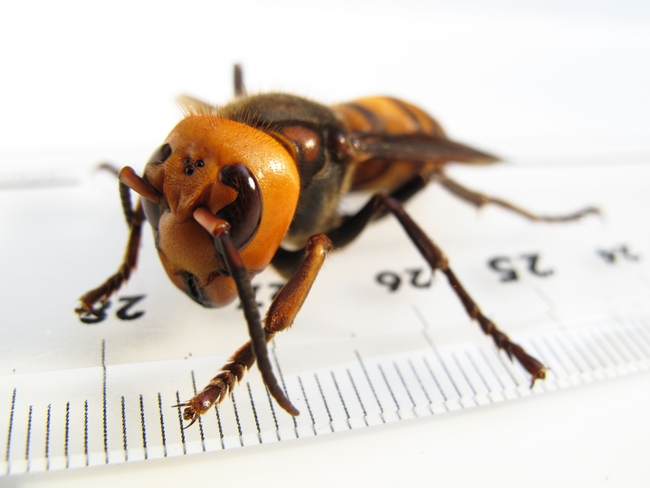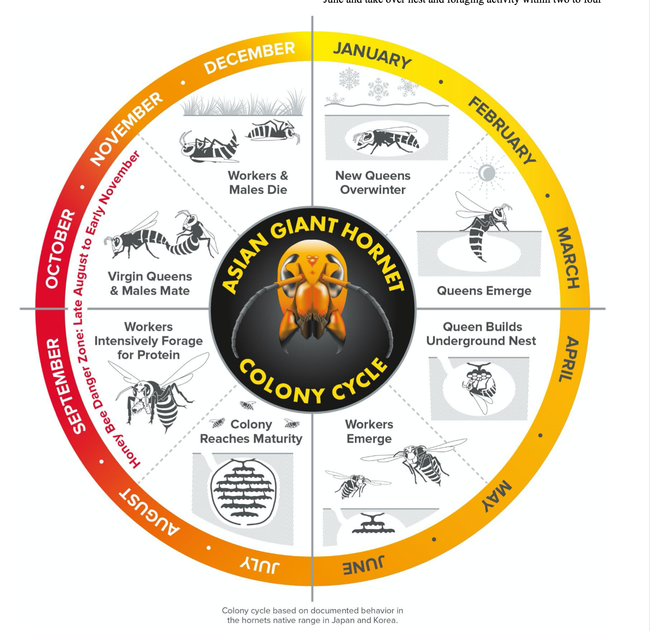- Author: Kathy Keatley Garvey
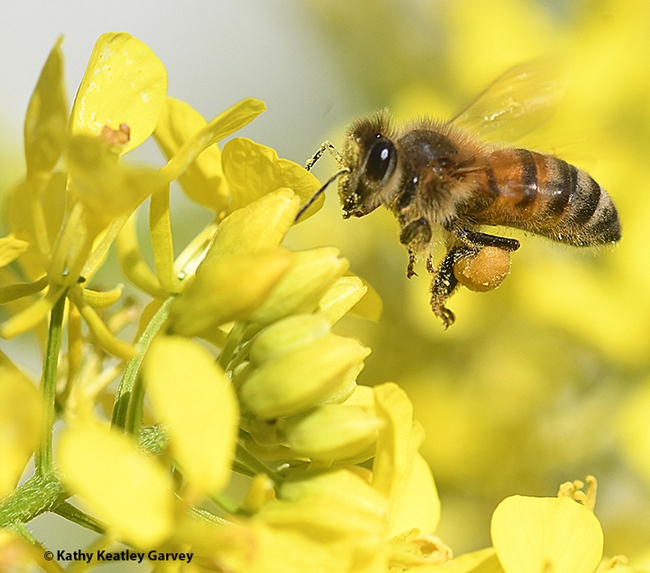
We know that European colonists introduced honey bees (Apis mellifera) into the Jamestown colony (now Virginia) in 1622.
But where did the Western honey bee originate? Scientists at York University, a public research university in Toronto, Ontario, Canada, recently discovered that it originated in Asia. Genetics told them so.
The abstract of the paper, "Thrice Out of Asia and the Adaptive Radiation of the Western Honey Bee," published in Science:
"The origin of the western honey bee Apis mellifera has been intensely debated. Addressing this knowledge gap is essential for understanding the evolution and genetics of one of the world's most important pollinators. By analyzing 251 genomes from 18 native subspecies, we found support for an Asian origin of honey bees with at least three expansions leading to African and European lineages. The adaptive radiation of honey bees involved selection on a few genomic 'hotspots.' We found 145 genes with independent signatures of selection across all bee lineages, and these genes were highly associated with worker traits. Our results indicate that a core set of genes associated with worker and colony traits facilitated the adaptive radiation of honey bees across their vast distribution."
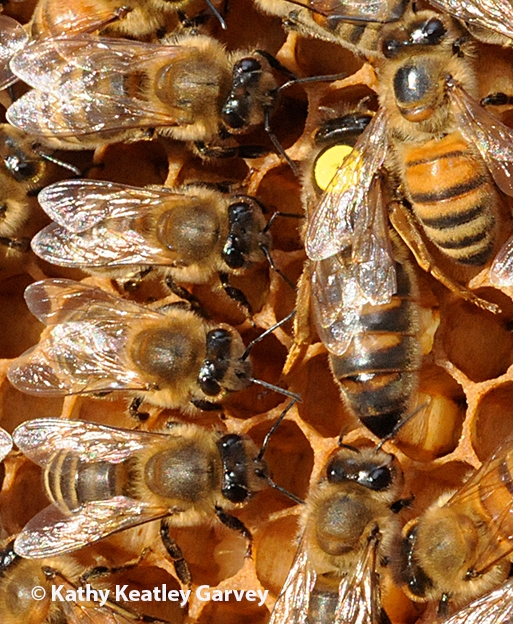
York University doctoral student Kathleen Dogantzis of the Faculty of Science led the research team. "Our research suggests that a core-set of genes allowed the honey bee to adapt to a diverse set of environmental conditions across its native range by regulating worker and colony behaviour," Dogantzis says in a Phys.Org article.
Why is it important to know the origin? To understand its evolution, its genetics and its adaptation and how this can relate to the current population of bees and to modern-day beekeeping.
Or, as they wrote in their scientific paper: "Resolving the ancestral origin and evolutionary expansion of A. mellifera will enhance our ability to identify derived and ancestral genetic mutations. This is especially relevant for tracing the evolution of derived phenotypes and for discerning how locally adapted subspecies may contribute to the fitness and diversity of managed colonies."
"In conclusion," they wrote, "we have presented compelling evidence that A. mellifera emerged in Asia with the remainder of extant honey bees but then expanded into its current distribution via Western Asia. This expansion event is marked by at least three independent colonization routes that gave rise to seven genetically distinct lineages. Modern populations of A. mellifera maintain high genetic diversity, which has allowed the species to adapt to diverse environments through repeated selection among a common set of genes. These genes are often related to worker phenotypes, supporting that the worker caste is key to the adaptative radiation of the species."
Jamestown Colony. The first honey bees to arrive in what is now the United States were what beekeepers call the "dark bee" subspecies of Northern Europe, Apis mellifera mellifera. Today the Italian bee, Apis mellifera ligustica is the most common bee the United States.
The Italian bee didn't arrive in America until 1859. "The American beekeeping public was enamored with the newly available yellow and gentle bees," bee breeder-geneticist and co-author Susan Cobey of Washington State University (formerly of UC Davis) wrote in a chapter of the book, Honey Bee Colony Health: Challenges and Sustainable Solutions. "As a result, Italian-type bees form the basis for most present-day commercial beekeeping stocks in the U.S. Following the arrival and success of honey bees from Italy, U.S. beekeepers developed an interest to try other honey bee subspecies." Cobey studied with Harry H. Laidlaw Jr. (1907-2003) of UC Davis, the "father of honey bee genetics" and for whom the university's bee biology facility is named.
And speaking of the introduction of honey bees into the United States, it took 231 for years for honey bees to arrive in California. Beekeeper Christopher A. Shelton introduced honey bees to the Golden State in 1853, establishing an apiary just north of San Jose. (Check out the bee plaque at the San Jose International Airport.)
Now we know that our beloved Western honey bee originated in Asia.
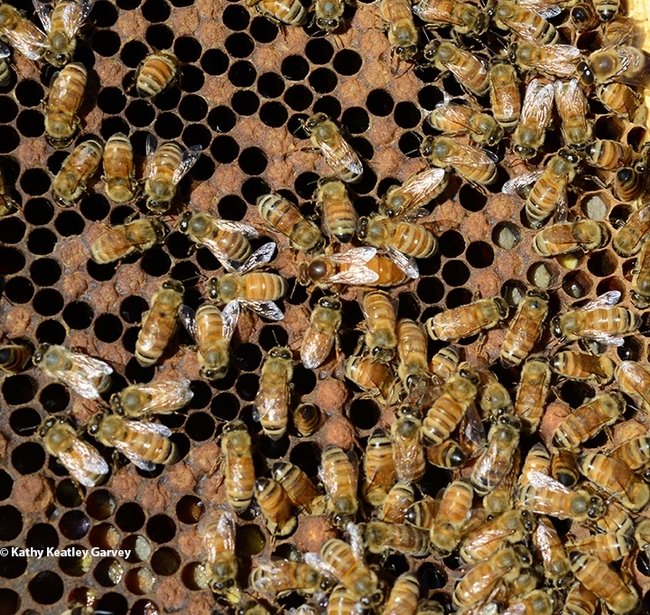
- Author: Kathy Keatley Garvey
If a queen bee were to celebrate Mother's Day (and she won't because she's too busy laying eggs), what a crowded festivity that would be.
Bee breeder-geneticist Susan Cobey of Washington State University, former manager of the Harry H.Laidlaw Jr. Honey Bee Research Facility at UC Davis, describes the queen as an "egg-laying machine."
"She's the mother of all the bees in the hive," saysCobey, who studied at UC Davis with Harry Hyde Laidlaw Jr., (1907-2003), "the father of honey bee genetics." During the peak season, the queen can lay up to 2000 eggs a day. That amounts to about 50,000 to 80,000 workers (sterile females) and 1000 to 2000 drones (males) in the hive.
On her maiden flight, the queen bee mates with some 12 to 25 drones in mid-air and then she heads back to the hive to lay eggs for the rest of her life, says Cobey, internationally renowned for her Carniolan bees and classes on instrumental insemination and bee breeding (stock improvement).
Yes, every bee in the hive has the same mother. Not so with the fathers.
In his book, The Honey Bee Hobbyist, the Care and Keeping of Bees, Norman "Norm" Gary, UC Davis emeritus professor of apiculture, writes: "All bees in a colony develop from eggs laid by the queen, so they all share the same mother. All bees in a colony develop from eggs laid by the queen, so they all share the same mother. But as a population, they typically have around 15 fathers."
As Gary points out: "The queen bee has no control over the drones that inseminate her. (The virgin queen) mates while flying, never inside the hive."
It's a matriarchal society. The girls (worker bees) do all the work; they serve as nurse maids, nannies, royal attendants, builders, architects, foragers, dancers, honey tenders, pollen packers, propolis or "glue" specialists, air conditioning and heating technicians, guards, and undertakers. So their abbreviated life (during the summer the life span of a worker bee is only four to six weeks) is not surprising. The drones, or males, serve only a reproductive function. Once they they mate, they die.
Honey bee geneticist Robert E. Page Jr., distinguished emeritus professor of entomology at UC Davis (and emeritus provost, Arizona State University) studied with Laidlaw for his doctorate at UC Davis. He pays tribute to Laidlaw in his book, The Art of the Bee: Shaping the Environment from Landscapes to Societies.
In Chapter Nine, "The Song of the Queen," Page reprinted a poem by E. B. White (Dec. 15, The New Yorker) objecting to instrumental insemination. White opined in the poem that the queen bee should "mate with whatever drone" she encounters.
Page reprinted Laidlaw's response, published in the San Francisco Chronicle, which said in part:
Her offspring slave throughout the day,
They feed her children as best they may
They would like to see a moment
Directed toward stock improvement.
If you're interested in bees and beekeeping, or just curious about these amazing superorganisms, these books read well on Mother's Day...and any other day.
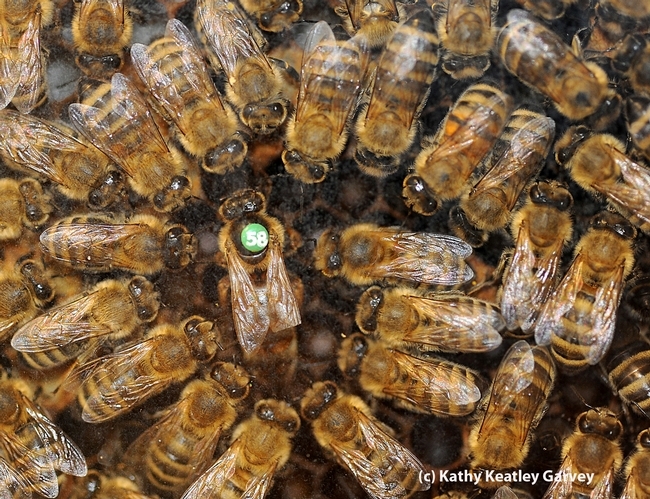
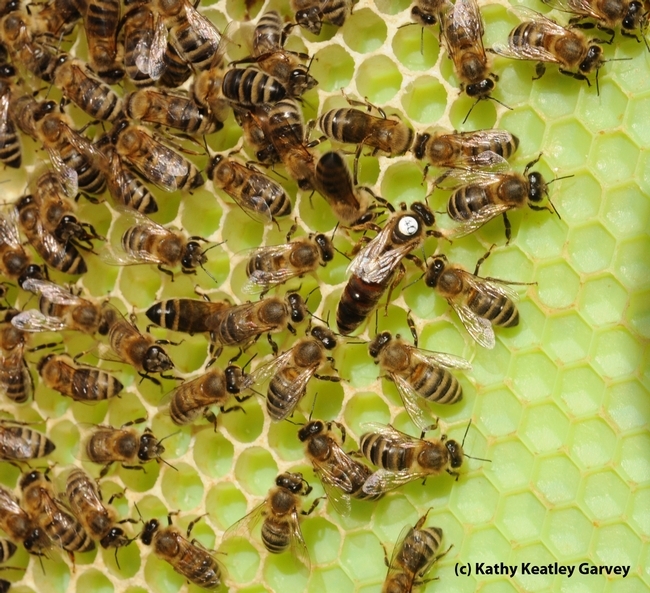
- Author: Kathy Keatley Garvey
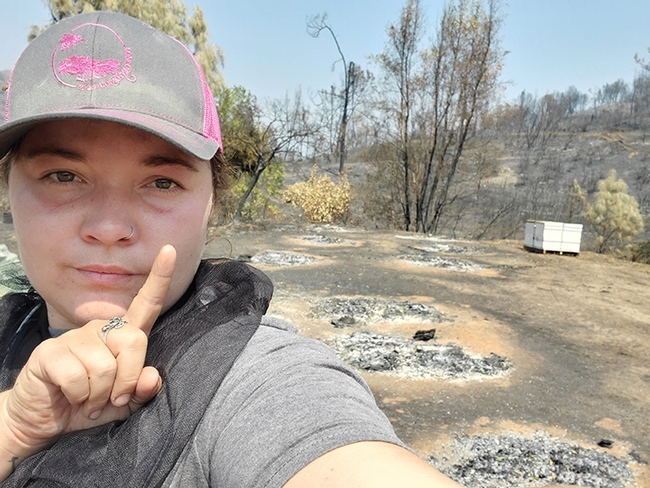
UC Davis alumnus and bee expert Elizabeth Frost, a technical specialist for bees with the New South Wales Department of Primary Industries, sadly knows the fire scene well.
Frost, a 13-year beekeeper, recently authored "24 Million Acres: Reports from Australia's Massive Fire Scar," published in the quarterly magazine, 2 Million Blossoms. The informative piece tackles the subject of Australian bushfires and it provides insight into the kind of scorched path lying ahead for California beekeepers.
"Bees don't abscond but stay with the hives as far as I can tell from beekeeper anecdotal evidence," Frost told us this week. "Where a 'cool' burn runs quickly through the bee yard, hives generally suffer from radiant heat. Post-fire, they should should be fed supplementally if there are no natural food sources where they can be moved to, and requeened. Otherwise, ongoing queen/productivity issues result."
At UC Davis, Frost worked with bee breeder-geneticist Susan Cobey (now at Washington State University) at the Harry H. Laidlaw Jr. Honey Bee Research Facility. The two colleagues are closely following the California wildfire disaster. "This is devastating--it will take years to recover," Cobey said.
An integral part of what's occurring both here and Australia, the colleagues said, is climate change. "Prolonged and potentially extreme bushfire seasons in Australia due to climate change is our present reality, not our future," wrote Frost in 2 Million Blossoms.
Meanwhile, the Australian Honey Bee Industry Council is keying on rebuilding the bushfire-devastated honey bee and pollination industry.
Frost described the 2019-20 bush fires in 2 Million Blossoms: "24 million acres were burnt in Australia's 2019-2020 bushfire season. In Australia's biggest beekeeping state, New South Wales (NSW), the 2019-20 bush-fires burnt through 13 million acres, 7% of the state's area, including 37% of NSW National Parks and 50% of State forests. NSW Apiarists' Association President Stephen Targett noted, “NSW Bushfires have burnt over 9,809 hives and wiped out the field of over 88,094 hives and burnt just over 5 million hectares of forests. With minimal autumn prospects, a small percentage of these affected hives will be suitable for almond pollination. While the mature almond orchards in Australia don't cover anywhere near as much land as in the United States, they still require around 220,000 hives in August, when mass bloom occurs in the Southern Hemisphere."
"This bushfire disaster was unprecedented in its impact on the Australian beekeeping industry which relies on native tall timber forests of nectar and pollen yielding trees to produce 30,000 tons of honey in a good year," Frost wrote. "Most of these species flower once every 3 to 4 years, unless soil moisture is below average for extended periods in which case some trees may not flower for up to 10 years. Australia's unique flora and dispersed bloom times means beekeepers must pay keen attention to botanical detail in order to effectively migrate to nectar flows that are not annual or even biannual. Australia lost vast swathes of vital natural sources of nutrition, species that provide car- bohydrates, proteins, amino and fatty acids, vitamins, and minerals. The bushfires destroyed prime habitat that functioned as a safe haven far from the threat of pesticides to honey bees and native pollinators alike."
Frost called attention to the Commonwealth Scientific and Industrial Research Organisation (CSIRO), a leading Australian federal government scientific agency, that has been conducting bushfire research for almost 70 years. "Bushfires are a natural part of the Australian landscape, necessary for the regeneration of many endemic plant species that evolved with the harsh climatic conditions of the world's lowest, flattest and (apart from Antarctica) driest continents," Frost pointed out. CSIRO reports that “bushfires are the result of a combination of weather and vegetation (which acts as a fuel for the fire), together with a way for the fire to begin – most commonly due to a lightning strike and sometimes human-influences (mostly accidental such as the use of machinery which produces a spark).”
The impact of climate change has led to longer, more intense fire seasons, Frost related, and an increase in the average number of elevated fire weather days, as measured by the Forest Fire Danger Index (FFDI). Last year saw the highest annual accumulated FFDI on record.
"Climate change doesn't cause fires directly, but has caused an increase in the occurrence of extreme fire weather and in the length of the fire season across large parts of Australia since the 1950s," Frost wrote. "In addition to 2019 being the driest year since records began in 1900, it was Australia's warmest year. In 2019 the annual mean temperature was 1.52 °C above average.”
Frost asked: "In the short term, how will the beekeeping industry evolve to cope with millions of acres of its floral resource burnt and unproductive, providing no bee forage for at least the next few years? Supplemental feeding, previously practiced sparingly in Australia, will have to become the norm for the country if beekeepers hope to bring colonies up to required colony strength as agreed in their almond pollination contracts."
Sadly, it's a long singed recovery as well for the California beekeepers victimized by the wildfires. (To offer financial support for Caroline Yelle, owner of Pope Canyon Queens, access the Gofundme account.)
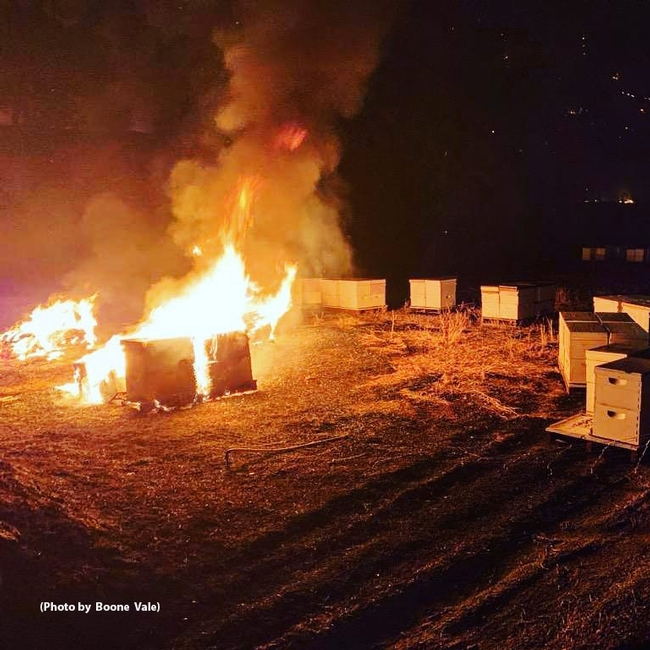
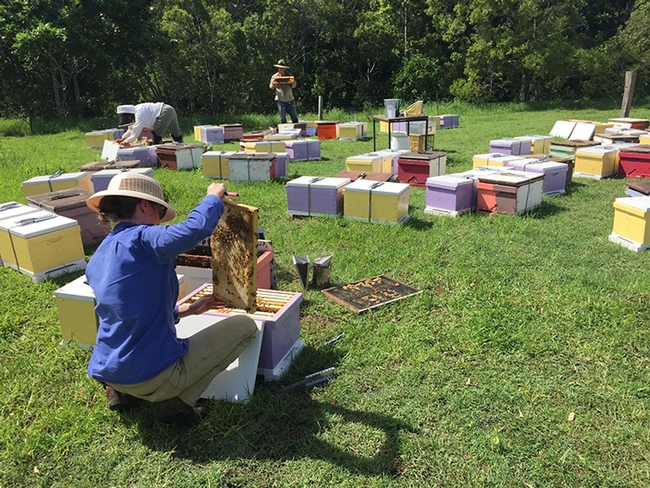
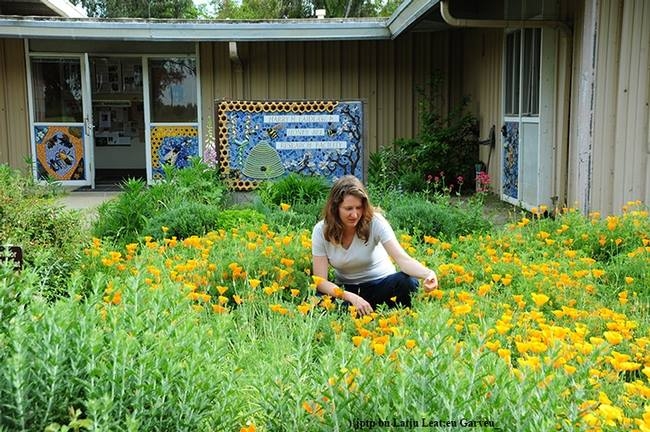
- Author: Kathy Keatley Garvey
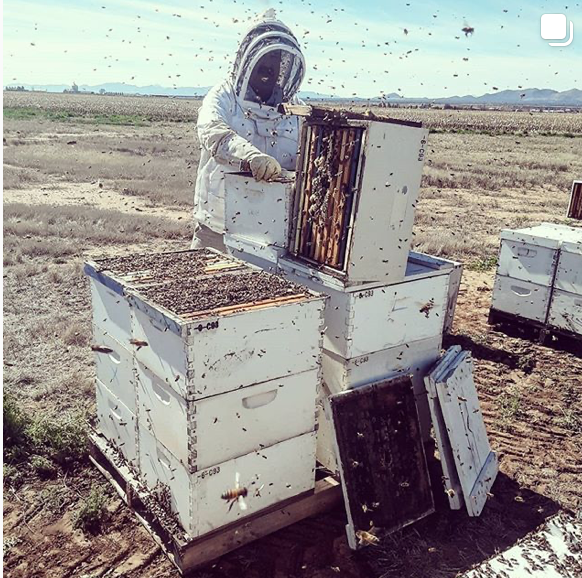
Caroline Yelle, 28, owner of Pope Canyon Queens (PCQ) at 8307 Quail Canyon Road, Vacaville, lost her business when the lightning-sparked Hennessey Fire, part of the LNU Lightning Complex Fire, swept through rural Vacaville on Aug. 19 from Napa County.
The raging wall of flame "destroyed everything."
She has nothing left but hope.
Pope Valley Queens is one of the nation's few women-owned queen bee breeder businesses. Yelle breeds bees for "a better tomorrow" and now "tomorrow" and "better" are almost singed from her vocabulary.
She lost 500 hives.
Her mentor, best friend and business partner Rick Schubert (who recently sold his business, Bee Happy Apiary, Vacaville), lost everything in the Hennessey Fire, including his newly remodeled home at 8307 Quail Canyon Road--and where the PCQ office was.
"I bought the company in 2017 from my mentor," said Yelle, who began working there in 2012. "This year, 2020 is my seventh year in producing queens."
"I was studying to be a lawyer in Canada," she related. "After I got my degree, I decided to move here and left everything behind to follow my dream with the bees and helping them."
Veteran beekeeper Schubert, who has kept bees for some four decades, is well known in the bee industry and agricultural world. He helped her settle in California and build the company, offering contacts and expertise. "Rick had just remodeled his house and that (the fire) happened," Yelle said. "He lost everything." Schubert's only surviving bees are the 100 hives he keeps in Dixon.
"Basically after selling Bee Happy, he invested in my company, Pope Canyon Queens," she said. "We lost everything together on different levels."
We Lost the Farm
"We (Rick Schubert and her) lost the farm, the house, the garage, the bees," Yelle said. "We have the majority of our bees on another property up in Pope Canyon Valley that also burned. We lost around 500 hives or $100,000 in livestock--minimum--that is not covered...and another $100,000 of benefits out of these hives. We are back to ground zero."
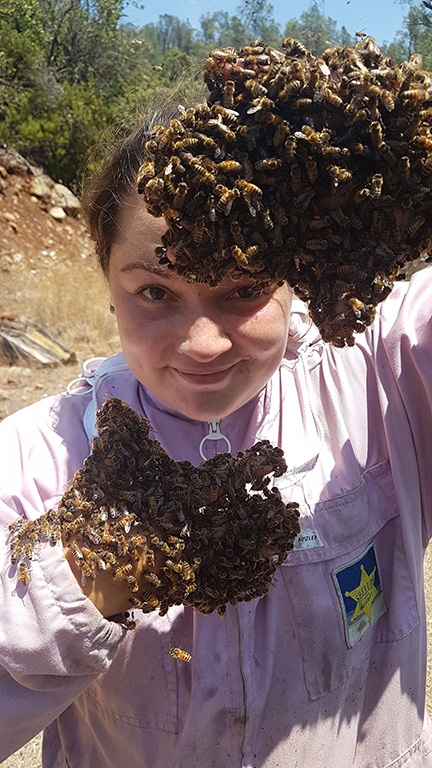
Yelle mainly breeds Carniolans, Apis mellifera carnica, a subspecies of the western honey bee and "a hybrid that we selected in Canada and we reproduce here in California for stronger genes."
"The Canadian beekeeping industry needs tons of early queens in the spring," she said. "We decided seven years ago to bring our northern and robust queen bee genetics, selected over more than 20 years, to produce here." She has an isolated mating station in Napa Valley (Pope Canyon Valley).
"Our goal was not to compete with the big queen guys that already export massive amount of queens but try to increase the level of quality standard into the queen importation issue in Canada and the United States," Yelle said. Over the years, they reached their goal of quality standard.
"However," she said, "we are still working to improve our genetics and to expand our production year after year."
Bee Source published this about the business in 2017: "Pope Canyon Queens LLC (PCQ) want and choose to be at the forefront breeding genetics to help bee populations to better defend themselves against mites, viruses, bacteria, pollination and commercial beekeeping stresses, pollution, depleting floral diversity and ever changing ecosystems. By confronting these challenges head on, PCQ will come to represent a turning point in the strengthening of bee populations. Its 'raison d'etre' is rooted in the urgency of grafting solid apicultural know-how onto strong genetics to meet today's challenge of breeding a better tomorrow."
'It Will Take Years to Recover'
Bee breeder-geneticist Susan Cobey of Washington State University, a former manager of the Harry H. Laidlaw Jr. Honey Bee Research Facility at UC Davis, called the fire "devastating." She knows of several beekeepers, including the Yelle-Schubert team, who lost everything in the tragic fire. "It will take years to recover."
"The story needs to be told," said Cobey, who breeds Carniolans. "These beekeepers work so hard. The impact of California agriculture will be huge, our breadbasket. It's about climate change, too."
"Sue is part of our family group," Yelle said. "We had programs on breeding stock and selection of genes." Yelle also works closely with bee breeder-geneticist Kim Fondrk, of the Laidlaw facility. For decades, Fondrk managed research bee colonies at the Laidlaw facility for Robert Page Jr., former chair of the UC Davis Department of Entomology who recently retired as provost at Arizona State University. Together Page and Fondrk wrote landmark research articles.
"Kim worked with and for us for us over the past years," Yelle recalled. Schubert also worked with bee scientist Norm Gary, emeritus professor, UC Davis Department of Entomology and Nematology, also known as an author, bee wrangler and musician. "We provided bees for Norm's research," Yelle related. Schubert provided bees for Gary's bee wrangling projects.
Now Yelle, who is accustomed to helping others, needs others' help.
"We need help with the bees that burned to be able to keep breeding them and bring back our livestock for next year pollination and to keep feeding the nation," Yelle said.
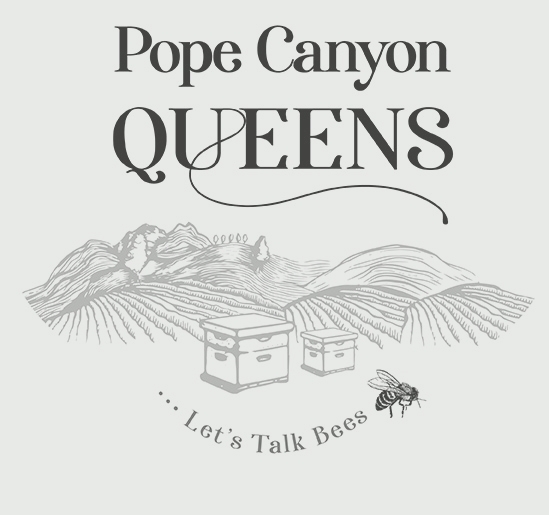
Yelle has set up a gofundme account, "Help Us Rebuild to Save the Bees," at https://gf.me/u/ys2vtw
"The help and support we are getting is really heartwarming," Yelle wrote on on the gofundme support page. "Thank you for the messages, the calls, the shares, the donations, the thoughts and everything. I see every single of your names and have such strong emotions about how much people care about us, about the bees and about their community. Some really good news so far: a bee company contacted us to help us rebuild the materials for lowest cost possible, my California family offered me a part of their barn for me to have a start before rebuilding."
Yelle is grateful that "someone saved a bee yard that was literally in the middle of one of the worst part of the fire," and she and a neighbor helped saved a mini farm from the fire. "Community is strong."
Strong...and from heartbreaking to heartwarming...
Contacts:
- Facebook: https://www.facebook.com/popecanyonqueens
- Email: popecanyonqueens@gmail.com
- Go Fund Me: https://gf.me/u/ys2vtw
- Instagram: https://www.instagram.com/popecanyonqueens/?hl=en
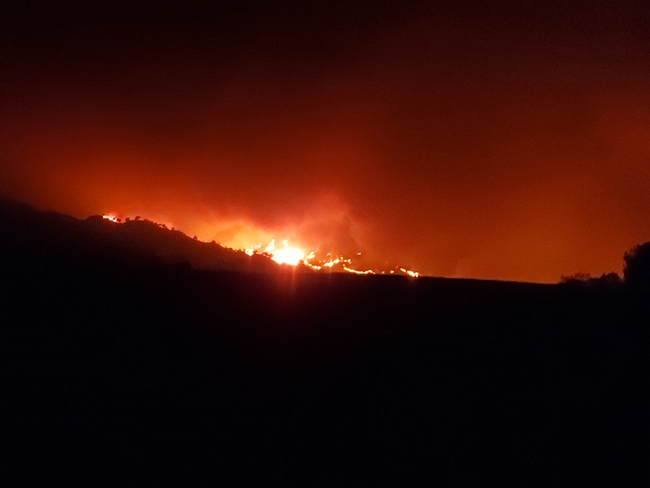
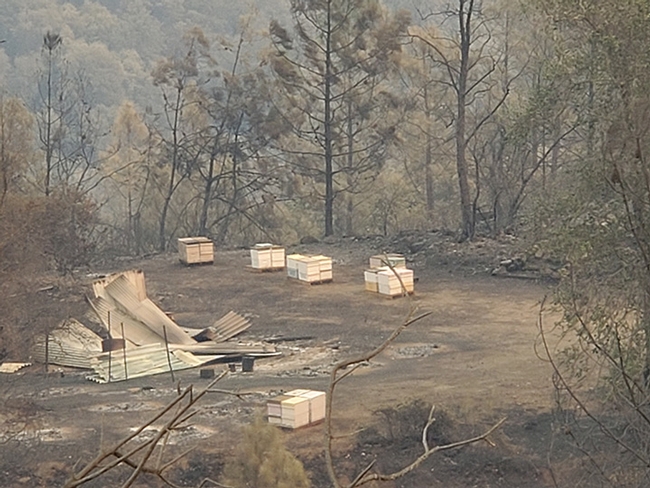
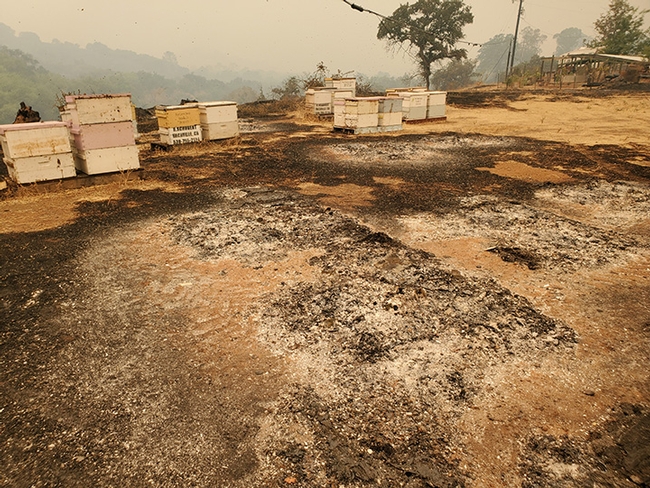
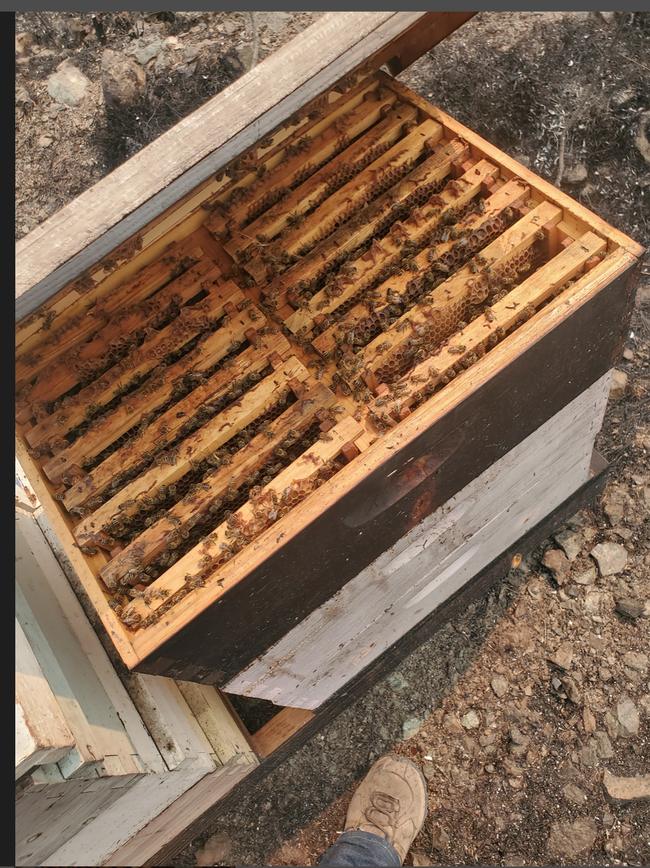
- Author: Kathy Keatley Garvey
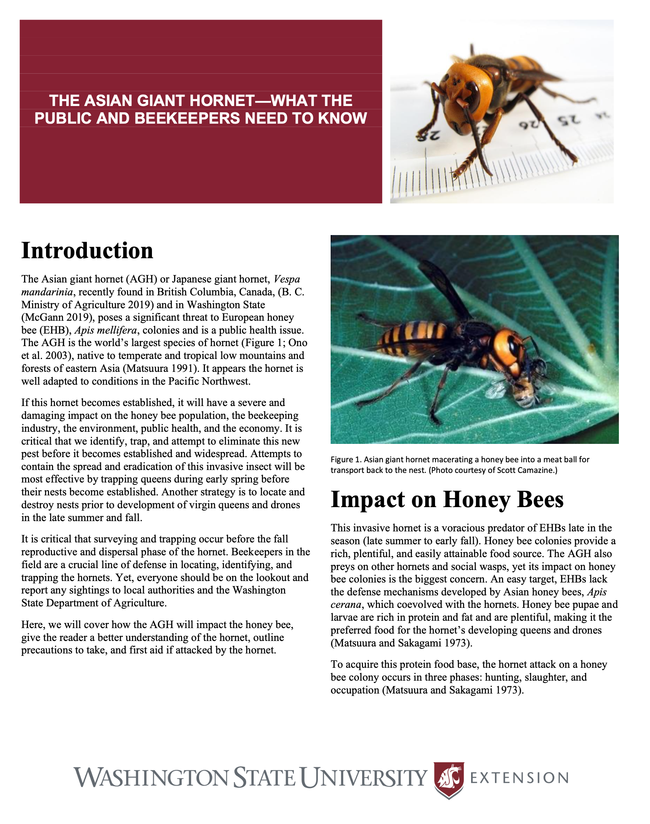
Remember the massive media frenzy earlier this year when "the murder hornet" became a household word? The media labeled it that, but let's call it AGH. It's a hornet, not some weaponized insect with super powers that belongs in a B-rated movie seen at a Saturday matinee. Drop the drink! Hold the popcorn!
The peer-reviewed publication is the work of two former UC Davis entomologists now with WSU: honey bee geneticist-researcher Susan Cobey, research associate, Department of Entomology, and Timothy Lawrence, associate professor and Island County Extension director (they are a husband-wife team), along with Michael Jensen, associate professor and Pend Oreille County Extension director.
The first four paragraphs zero in on what this is all about:
"The Asian giant hornet (AGH) or Japanese giant hornet, Vespa mandarinia, recently found in British Columbia, Canada, (B. C. Ministry of Agriculture 2019) and in Washington State (McGann 2019), poses a significant threat to European honey bee (EHB), Apis mellifera, colonies and is a public health issue. The AGH is the world's largest species of hornet (Figure 1; Ono et al. 2003), native to temperate and tropical low mountains and forests of eastern Asia (Matsuura 1991). It appears the hornet is well adapted to conditions in the Pacific Northwest.
"If this hornet becomes established, it will have a severe and damaging impact on the honey bee population, the beekeeping industry, the environment, public health, and the economy. It is critical that we identify, trap, and attempt to eliminate this new pest before it becomes established and widespread. Attempts to contain the spread and eradication of this invasive insect will be most effective by trapping queens during early spring before their nests become established. Another strategy is to locate and destroy nests prior to development of virgin queens and drones in the late summer and fall.
"It is critical that surveying and trapping occur before the fall reproductive and dispersal phase of the hornet. Beekeepers in the field are a crucial line of defense in locating, identifying, and trapping the hornets. Yet, everyone should be on the lookout and report any sightings to local authorities and the Washington State Department of Agriculture.
"Here, we will cover how the AGH will impact the honey bee, give the reader a better understanding of the hornet, outline precautions to take, and first aid if attacked by the hornet."
The fact sheet provides crucial information, including what the public and beekeepers need to know, how to trap the hornets, where to report sightings, and information about the life cycle, the stinger, avoidance, and first aid. It details the public health issue and defines "What is a hornet?"
We've heard folks argue that AGH is a "hornet, not a wasp." Noted hymenopterist Lynn Kimsey, director of the Bohart Museum of Entomology and professor of entomology at UC Davis, points out that hornets ARE wasps.
WSU Extension defines a hornet this way:
"A hornet is simply a large wasp. Generally, wasps of the class or genus known as Vespa are considered hornets. Interestingly, there are no true hornets (Vespa) native to North America. The European hornet (Vespa crabro) is well established in much of the eastern half of the United States. The European hornet is not a major threat to honey bees."
"Hornets are part of a large order of insects known as Hymenoptera that include bees, wasps, ants, and sawflies. Worldwide, there are more than 115,000 species belonging to the order Hymenoptera (Hunt and Toth 2017). Most of this group of insects are beneficial for pollination and pest control. There are two types of hornets, solitary and social (Lee et al. 2016). Solitary hornets hunt various insects and spiders. Their 'stinger' is primarily used to paralyze their prey. They often lay an egg on the immobilized victim, and when the egg hatches, the larvae consume the still-living host. Solitary wasps generally do not sting humans and usually are not aggressive unless provoked."
"Social wasps, on the other hand, do use their stingers to defend their nests and can be very aggressive and will readily sting. The most common social wasp in the United States is the yellowjacket. The four most common yellowjacket species in Washington are the western yellowjacket (Paravespula pensylvanica), the common yellowjacket (Paravespula vulgaris), the aerial yellowjacket (Dolichovespula arenaria), and the German yellowjacket (Paravespula germanica) (Berry and Mooney 1998; Landolt and Antonelli 2003)."
"The recently introduced Asian giant hornet (AGH) is also a social wasp. When foraging for food in spring, the AGH ;is not highly aggressive—unless its nest is disturbed. Late summer and fall, with the high demand for protein, they become very aggressive when attacking or occupying a honey bee colony."
AGH appeared in the news last month when the Washington State Department of Agriculture announced it had trapped aVespa mandarinia near Birch Bay in Whatcom County. It was trapped July 14 and identified during processing on July 29. "This was the first hornet to be detected in a trap, rather than found in the environment as the state's five previous confirmed sightings were," according to the news release.
"Because the number of Asian giant hornet workers increases as a colony develops, residents should be most likely to see an Asian giant hornet in August and September," the news release related. "If you think you have seen one, report it at agr.wa.gov/hornets. Provide as much detail as you can about what you saw and where. Also, include a photo if you can safely obtain one, and if you come across a dead specimen keep it for potential testing. You can visit WSDA's website at agr.wa.gov/hornets to learn more about Asian giant hornets. You can also submit questions the WSDA Pest Program at hornets@agr.wa.gov or 1-800-443-6684."
At least we never saw a 64-point bold, all-capped, World War II-sized newspaper headline that screamed "MURDER HORNET TRAPPED!"
But some of the misidentifications of Vespa mandarinia flowing in are incredible. Check out Stephane de Greef's Facebook page on "Is This a Murder Hornet?" The latest one spotlighted is a...wait for it...beetle.
